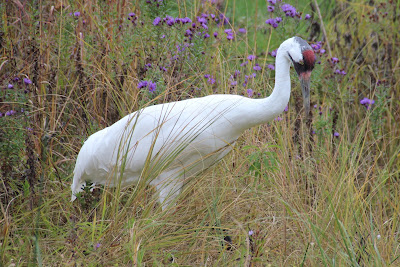This post will wrap up our visit to the International Crane Foundation in Baraboo, Wisconsin earlier this month.

Black-Necked Crane
The black-necked crane is the only alpine crane in the world, residing almost exclusively at high altitudes on the Tibetan Plateau and in the Himalaya.

Eurasian Crane
The Eurasian Crane, also known as the Common Crane, is the most widely distributed of all cranes, occurring in over 80 countries.

Eurasian Crane, exhibiting aggression
I've saved the two North American species of cranes for last. First, the Sandhill Crane, the world's most abundant crane, with populations that are stable to increasing.

Sandhill Crane
The early spring gathering of Sandhills on the Platte River in Nebraska is among the greatest wildlife spectacles on the continent, with over a quarter of a million birds present at one time.
And, lastly, the Whooping Crane, the tallest bird in North America, standing at approximately 5 feet (1.5 meters), and the rarest of all species of cranes. Their current population is estimated at approximately 600 birds.

Following is a video describing the effort to teach migration habits to young Whooping Cranes that have been raised in captivity:
I hope you've enjoyed these posts about the cranes as much as I enjoyed seeing, photographing, and learning about them.



Amazing shoots of these beautiful creatures. I like my birds, but really like the large ones like these.I have been watching a group of Sandhills for a few years, the only ones nesting in my state. I have been over to the to the Sandhill festival a number of times.It is amazing to see so many at one time.
ReplyDeletestill as beautiful as ever Linda
ReplyDeletethey sure are beauties.
ReplyDeleteBeautiful pictures. I am still hoping to see a Whooping Crane some day.
ReplyDeleteThey are so beautiful, Linda! I hope to see a crane here in Montreal one day but if they do come here they keep themselves well hidden! Love your photos!
ReplyDeleteThanks, Steve. I remember your mentioning that you'd been to see the great gathering of Sandhills. It's something we'd like to do someday.
ReplyDeleteThank you, Margaret.
Yes, they are, Tex. It was really a treat to see them.
Thanks, Ruth. I doubt that you'll see a Whooping Crane in the wild, as rare as they are. But I hope you do get to see one. It's special, whether in the wild or in captivity.
They ARE beautiful, Linda. I hope you get to see some, even if it's at a bird sanctuary or someplace like that. It's a thrill to see them.
Lovely captures, Linda, and I really enjoyed the video, who would have thought... :)
ReplyDeleteThank you, Petra. The video was interesting, wasn't it? I read that an effort had been made to place Whooping Crane eggs in the nests of Sandhill Cranes and allowing them to be raised by the Sandhills, learning migration from their foster parents. It wasn't successful, though, because the Whooping Crane young sought to pair up with Sandhill mates. The experiment was abandoned.
ReplyDelete